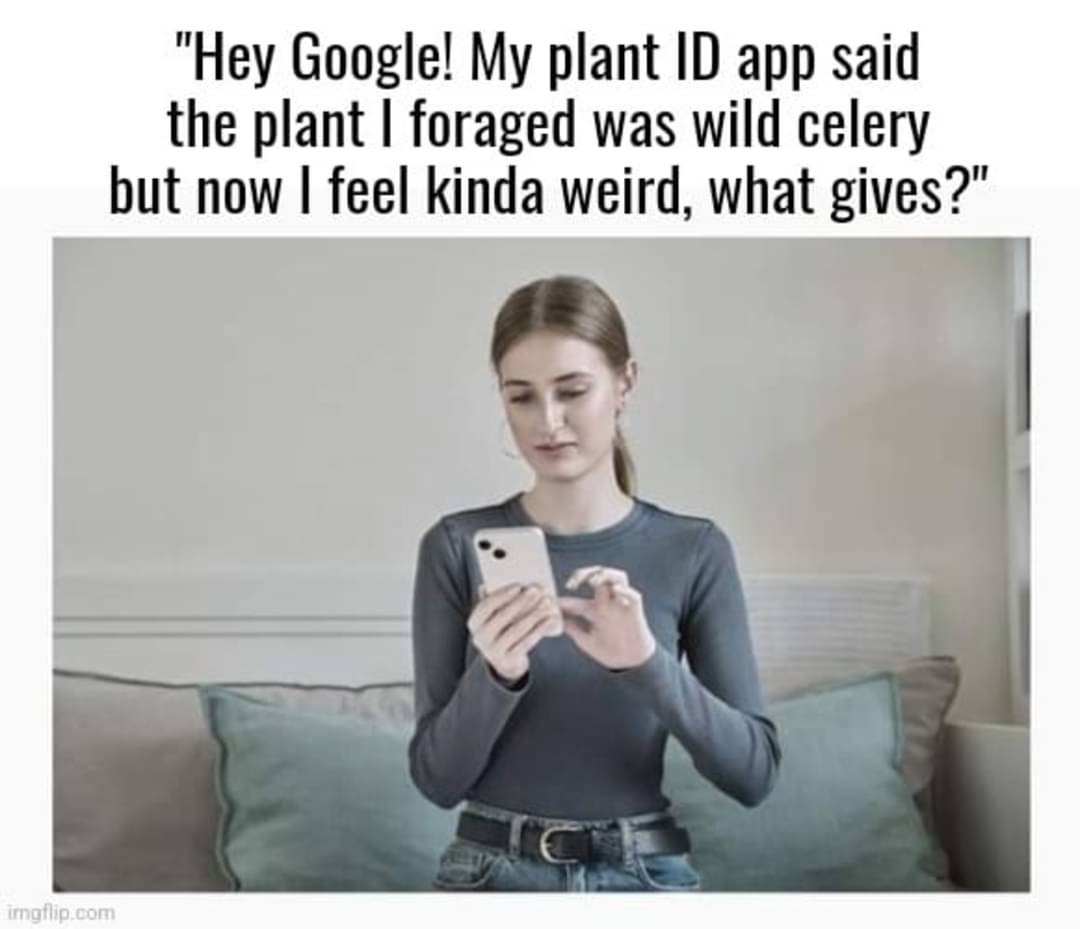I know nothing about plants.
Science Memes
Welcome to c/science_memes @ Mander.xyz!
A place for majestic STEMLORD peacocking, as well as memes about the realities of working in a lab.

Rules
- Don't throw mud. Behave like an intellectual and remember the human.
- Keep it rooted (on topic).
- No spam.
- Infographics welcome, get schooled.
Research Committee
Other Mander Communities
Science and Research
Biology and Life Sciences
- [email protected]
- [email protected]
- [email protected]
- [email protected]
- [email protected]
- [email protected]
- [email protected]
- [email protected]
- [email protected]
- [email protected]
- [email protected]
- [email protected]
- [email protected]
- [email protected]
- [email protected]
- [email protected]
- [email protected]
- [email protected]
- [email protected]
- [email protected]
- [email protected]
- [email protected]
- [email protected]
- [email protected]
- !reptiles and [email protected]
Physical Sciences
- [email protected]
- [email protected]
- [email protected]
- [email protected]
- [email protected]
- [email protected]
- [email protected]
- [email protected]
- [email protected]
Humanities and Social Sciences
Practical and Applied Sciences
- !exercise-and [email protected]
- [email protected]
- !self [email protected]
- [email protected]
- [email protected]
- [email protected]
Memes
Miscellaneous
Yeah, I am not botanical enough to get this, but presumably it's something poisonous?
Apiaceae, the carrot family, is full of wild species that are incredibly poisonous. Basically if it looks like a carrot in the wild dont eat it or you might die.
Same goes for if it looks like a Tomato, those are nightshades and the only ones I know about that aren't deadly to eat are tomatoes and peppers, and the peppers only because the poison they developed doesn't kill you it just makes you feel like your entire digestive tract is on fire.
Eggplants, potatoes, ground cherries, tomatillos, huckleberries are all edible too. That said you are right, if it is growing in the wild assume it will kill you. Don't eat it.
Huckleberry varieties are all Nightshades? Does that mean blueberries are Nightshades?
Huckleberries and blueberries are not related closely at all. Huckleberries are in the nightshade family, Solanaceae. Blueberries are in the blueberry family, Ericaceae. Their morphologies, or growth forms, are very very different.
I didn't realise blueberries were in the Heather family but it makes sense.
Totally. Once you see the flowers, you can't unsee it. Families are based on flower structures. Once you see and begin to know the flower structures, you'll know a sage is a mint, a hibiscus is a mallow, a manzanita is a blueberry, on and on. Fun free puzzles if nothing else.
Youll like this little daily game about guessing plants
Oh crap. This is Wordle, but for me! Thank you!
You must be confused, or perhaps you're not talking about the same species that I am thinking about. Huckleberries, genus Gaylussacia, are definitely in the same family as blueberries, Vaccinium. They're both Ericaceae, in the subfamily Vaccinioideae. Gaylussacia is definitely not in Solanaceae.
Two species of blueberry as well as cranberry grow natively in a few bog habitats near my home, and huckleberries are also sympatric with these species.
ETA: I saw some context from other comments in this chain that somebody else already beat me to this. I, too, didn't realize that there were, if you were, "false" huckleberries in the nightshade family.
To add to both of our shared confusion, there is even a false huckleberry from within the blueberry family, but instead the Ericoideae subfamily: https://www.inaturalist.org/taxa/553849-Rhododendron-menziesii. I have no experience with this plant, or even really this subfamily, as it isn't exactly endemic to my neck of the woods.
True or false, common names are confusing. Huckleberries are called huckleberries, regardless of family or genus. I wasn't confused, I was naive. Just didn't know that other plants were called huckleberries. Binomial nomenclature rocks.
When I looked into this what I came away with was there was a single species of nightshade that is sometimes called "Garden Huckleberries", which are unrelated to what are commonly known as "true huckleberries". True Huckleberries are all in the genera Vaccinium and Gaylussacia, which are contained in the family Ericaceae, of which "Ericacaea" is either an alternative or misspelling.
Potatoes, believe it or not, are also nightshades.
Actually I'm pretty sure those can poison you if you don't grab them at the right time
Yes, and also it can be poisonous later down the line after harvested
The berries of potatoes are poisonous, just the tubers aren't unless exposed to sunlight.
And tobacco
Ah ok, so like Queen Anne's Lace and Poison Hemlock?
Yeah, water hemlock, cowbane, fool's parsley, wild parsnip, etc, etc.
Yes
Yep. Hemlock is one of them
Look up “Sardonic Grin”. It’s one of those things that makes you think this is interesting, and also never going to eat wild plants again.
Or hallucinogenic? Although if there were an easy-to-forage hallucinogen that looked like celery I'm pretty sure I'd know about it.
A trip down the river Styx
The roots of the common reed contain dimethyltryptamine. Not sure if it's enough to make a tea, never heard of anyone doing it.
Hemlock water-dropwort looks like celery. It causes muscle spasms, which at times results in the victim dying with a grin on their face.
Looks pretty similar to hemlock.
Neither do the LLMs you used to identify your “wild celery” lol
it baffles me that there are ID apps that don't follow the model of 1) very clearly SUGGESTING what it MIGHT be, and 2) only present a level of precision it's actually confident in
having it always present a specific species and just pick the most likely one is so dumb and irresponsible of the designers.
It's a fundamental problem with the tech in general. It inherently has no concept of "I don't know" and will just be confident, specific, and wrong.
That's blatantly untrue. My plant ID app gives multiple suggestions with certainty percentages.
What's your plant ID app?
inaturalist does this, and also lets other people suggest an ID so you can get a consensus.
This is blatantly false. Classification tasks like this all have a level of certainty for each possible category - it's just up to the person writing the software to interpret those levels of certainty in a way that's useful to the user. Whether this is saying "I don't know" when the certainties are too spread out, or providing a list of options like other people in this thread have said their apps do. The problem is that "100% certainty" comes off well with the general public, so there's a financial incentive to make the system seem more certain than it is by using a layer (from memory it's called Softmax?) that will return only the category with the highest degree of certainty.
uhhh do you have any clue how it actually works? i mean maybe there's some sort of visual AI tech that doesn't let you make it say "idk fam" but the standard stuff just gives a point value to each result, and you could just.. have a minimum limit..
and like i'm pretty certain the current chatbots available generally are capable of responding that they don't know, they're certainly capable of "recognizing" when it's a topic they're not allowed to talk about.
This actually is a symptom from the sort of "beneficial" overfit in Deep Learning. As someone whose research is in low data, long tails, and few shot learning, there's a few things that smaller networks did better in generalization, and one thing they particularly did better (without explicit training for it) is gauging uncertainty. This uncertainty is sometimes referred to as calibration. Calibrating deep networks can yield decent probabilities that can be used to show uncertainty.
There are other tricks for this. My favorite strategies prep the network for learning new things. Large margin training and the like are a good thing to look into. Having space in the output semantic space (the layer immediately before the output or earlier for encoder decoder style networks) allows for larger regions for distinct unknown values to be separated from the known ones, which helps inherently calibrate the network.
Oh so poisoning the elderly with hemlock was more common than just executing annoying philosophers eh ?
My app only says "dicot" so now that's what I call all plants.

I don't know who is using these things. If you've got a phone and a signal then you've got a shop. Go to it and buy the things you need.
I forage and hunt for food. It lets me get things I can't get at the grocery store and it's free.
I use them. It helps me identify "weeds" so I can know if they're good for pollinators or have to be removed immediately for invasiveness.
Example: I often keep a couple milkweed plants growing for monarch butterflies.
I would say that most people foraging wild plants in western societies aren't doing it to sustain themselves. It is usually has to do with learning more about their surroundings, to revive old knowledge or for fun. And as long as you double check, play close attention to detail and most importantly don't blindly follow an app you should be completely fine with this. (Well, foraging plants from the Apiaceae (the carrot family) is not really a good idea due to the close resemblance of most of its members.)
It's for beginners. My son uses it to learn about plants in our yard.
It might be wrong, but that's the next step of parenting.
